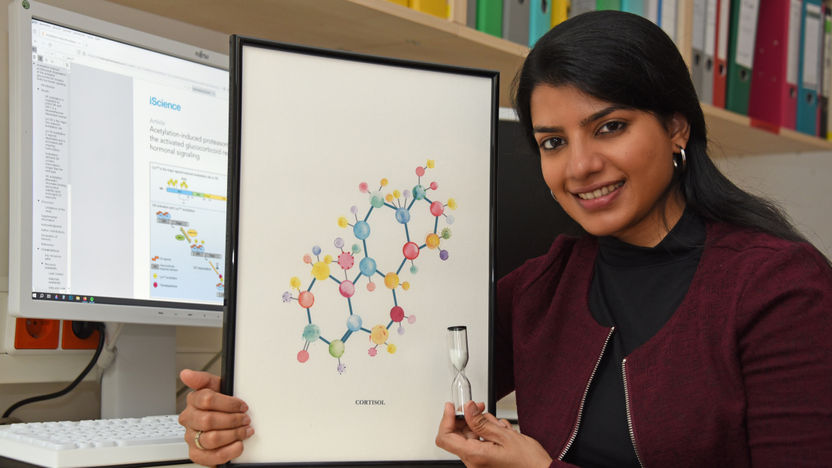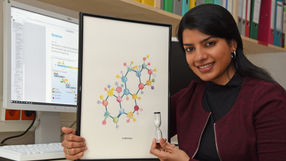Acetylation: a Time-Keeper of glucocorticoid Sensitivity
Understanding the regulatory mechanism paves the way to enhance the effectiveness of anti-inflammatory therapies
Advertisement
cortisol, also commonly known as the stress hormone, belongs to the family of glucocorticoids. In addition to its physiological function, synthetic derivatives of cortisol are also used as anti-inflammatory drugs. In the cell, the hormone acts by binding to the glucocorticoid receptor (GR), which then acts as a transcription factor to regulate the activity of certain target genes. In order to switch off the cortisol signal again, the cell breaks down the cortisol-bound GR over time. Therefore, chronic stress or long-term hormone therapy can deplete the cellular GR supply and lead to a loss of sensitivity to cortisol. The molecular mechanisms that lead to this cortisol resistance are still largely unknown.

Computer generated image

Dr. Aishwarya Iyer-Bierhoff has discovered a molecular “hourglass” for cortisol action.
Anne Günther/Universität Jena


The research group led by Prof. Thorsten Heinzel at the Friedrich Schiller University Jena, together with researchers from the Leibniz Institute on Aging - Fritz Lipmann Institute (FLI) in Jena and the University of Ulm, have now been able to clarify an important aspect of cortisol resistance. The study was funded by the Carl Zeiss Foundation as part of the IMPULS research consortium and was recently published in the journal "iScience".
The Proteomics Technology Unit of the FLI was also crucial to the project, providing support with mass spectrometry to investigate the exact molecular composition of the GR. This revealed a chemical modification, known as acetylation, which only occurs when the GR is bound to cortisol. However, this acetylation does not change the function of GR as a transcription factor, as observed from the measurement of gene activity by RNA sequencing, which was also carried out at the FLI by the Next Generation sequencing Core facility. However, further investigations showed that the modified GR is less stable and is degraded more quickly. “This finding suggests that the cell can adjust its response to cortisol by acetylating GR. Simply put, higher levels of acetylation, shorten the effect of cortisol”, explains Dr. Aishwarya Iyer-Bierhoff, the first author of the study.
Elucidation of this regulatory mechanism opens up new possibilities for counteracting cortisol resistance in order to improve the efficacy of anti-inflammatory therapies. In addition, new strategies can be developed to counteract the negative effects of stress- and age-related excess cortisol.
The Leibniz Institute on Aging – Fritz Lipmann Institute (FLI) – upon its inauguration in 2004 – was the first German research organization dedicated to research on the process of aging. Around 350 employees from around 40 nations explore the molecular mechanisms underlying aging processes and age-associated diseases. For more information, please visit www.leibniz-fli.de.
The Leibniz Association connects 97 independent research institutions that range in focus from natural, engineering, and environmental sciences to economics, spatial, and social sciences and the humanities. Leibniz Institutes address issues of social, economic, and ecological relevance. They conduct basic and applied research, including in the interdisciplinary Leibniz Research Alliances, maintain scientific infrastructure, and provide research-based services. The Leibniz Association identifies focus areas for knowledge transfer, particularly with the Leibniz research museums. It advises and informs policymakers, science, industry, and the general public. Leibniz institutions collaborate intensively with universities – including in the form of Leibniz ScienceCampi – as well as with industry and other partners at home and abroad. They are subject to a transparent, independent evaluation procedure. Because of their importance for the country as a whole, the Leibniz Association Institutes are funded jointly by Germany’s central and regional governments. The Leibniz Institutes employ around 20,500 people, including 11,500 researchers. The financial volume amounts to 2 billion euros. For more information: www.leibniz-gemeinschaft.de/en/.
Original publication
Other news from the department science
Most read news
More news from our other portals
See the theme worlds for related content
Topic World Mass Spectrometry
Mass spectrometry enables us to detect and identify molecules and reveal their structure. Whether in chemistry, biochemistry or forensics - mass spectrometry opens up unexpected insights into the composition of our world. Immerse yourself in the fascinating world of mass spectrometry!

Topic World Mass Spectrometry
Mass spectrometry enables us to detect and identify molecules and reveal their structure. Whether in chemistry, biochemistry or forensics - mass spectrometry opens up unexpected insights into the composition of our world. Immerse yourself in the fascinating world of mass spectrometry!

























































